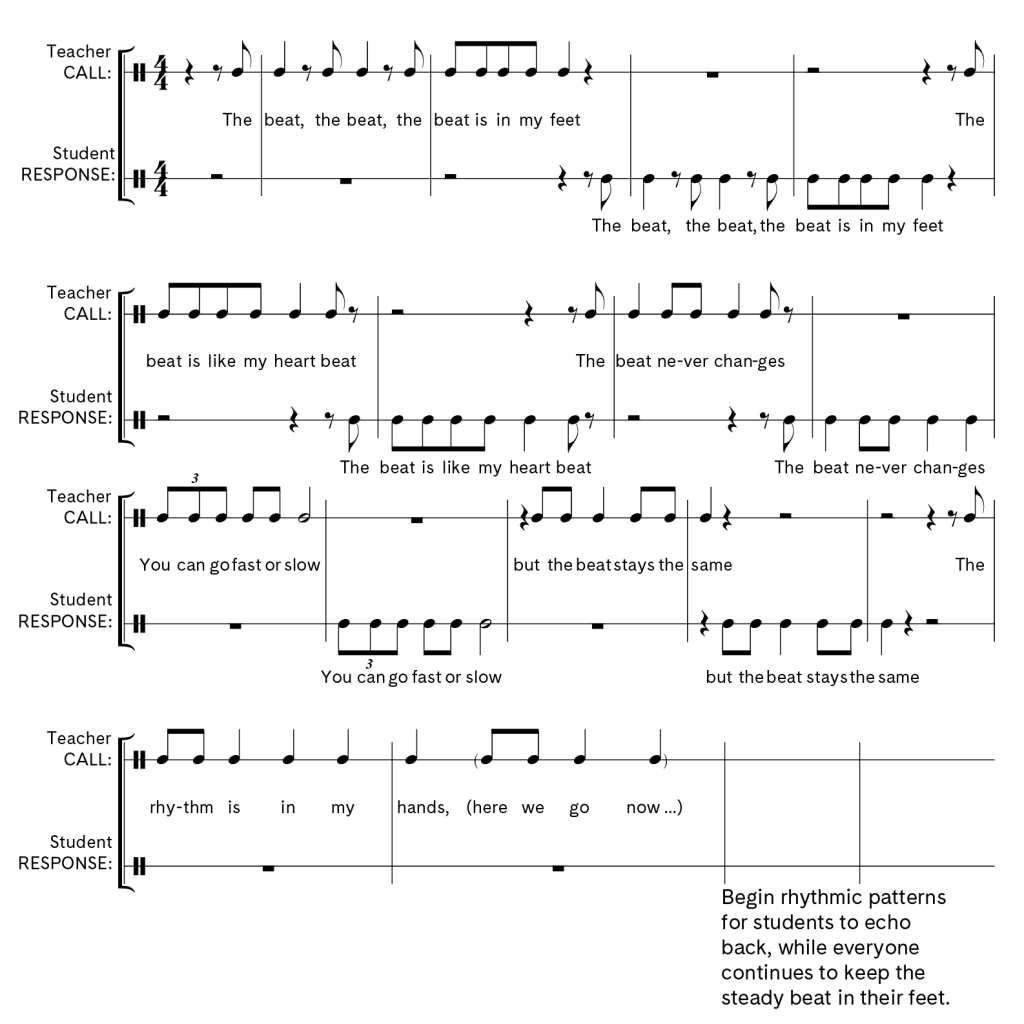Vocal and Body Warm Ups
Teachers are encouraged to start each lesson with warm-ups in order to establish a routine that fosters healthy vocal technique, kinesthetic learning, and active listening. Each of the following warm-ups can stand alone or be combined at the discretion of the teacher to best meet the needs of each classroom.
Finding Your Breath
Smooth and Bouncy Breath
Smooth Breath: Students will explore how to breathe smoothly and steadily
- Using both hands, have students create an “O” shape by touching index finger to index finger and thumb to thumb.
- Instruct them to put the “O” around their belly button and take slow, silent, and deep breaths pushing the “O” out in a smooth motion while keeping their shoulders still.
- Add a “sh” or “th” sound to the breath.
Bouncy Breath: Students will learn to control their breath by bouncing it.
- Taking the “O” from Smooth Breath, have students bounce the “O” in short motions. Add a “sh,” “th,” or “t” sound to the breath.
- What is different or the same when you add different letter sounds while you exhale?
- What is happening inside your body as you breathe?
- Is anything moving? What is moving?
Vocal Warm-Ups
In the following exercises, students will practice healthy singing technique by exploring posture, diction, and the full range of their voices.
Sirens
Students will explore the full range of their voices by pretending they are police cars on a chase with their sirens on.
- Model the vocal contour of the siren (going from a low pitch to a high pitch and back down again), while matching the vocal shape with your hand and arms.
- Ask students to echo you so that they can begin to feel and understand the difference between high and low pitches by using their bodies and voices.
- Once students are comfortable, choose a student leader to “conduct” the sirens with his or her body.
Tongue Twisters
Tongue twisters are a fun way to warm up the lips, teeth, and tongue—our articulation tools. This will help encourage proper diction, making words easier to understand when singing.
- Here are some examples of tongue twisters:
- Chester cheetah ate a chunk of cheap cheddar cheese.
- Mommy made me mash my M&Ms.
- Daddy made me dump them down the drain.
- Ask the class to say a tongue twister slowly at first, and then try to speed up.
- Once the students are comfortable, have them sing the tongue twister on one pitch, starting on middle C and ascending by half steps.
- Once they are comfortable singing the tongue twister, try varying it. For example:
- Have the class try and sound like one voice as the tongue twister speeds up
- Change the beginning consonant in the tongue twister.
- Have students write their own tongue twisters.
A Posture Song
Proper posture helps keep the breath connected to the voice when singing. When a body is hunched, the air gets stuck.
- Students perform the movements described in the lyrics of “Feet, Feet Flat on the Floor” as they sing.

Hoot Owl
Students will warm up their head and chest voices while exploring vocal range and legato singing. Head voice often refers to the upper vocal register and can be described as light, floating, and open. Exploring chest voice can help students easily find their head voices.
- Have students place a hand in the middle of their chest (between their sternum and collarbone) and say “huh” in a deep voice. This should produce vibrations in the chest. Explain that this is their chest voice.
- Next, ask students to hoot like an owl. They should no longer feel the chest vibration. Explain that this is their head voice.
- Using their owl (head) voice only, ask students to sing the exercise “Hoot Owl” starting on middle C and ascending by half step to F (or as high as your class can continue while maintaining healthy singing).

Explore Different Voices
- Lead a discussion with the class about the four different ways they can use their voices—whispering, talking, calling, and singing.
- Where would we use our whispering voice? (e.g., library or movie theater
- Where would we use our talking voice? (e.g., classroom, telephone, or dinner table)
- Where would we use our calling voice? (e.g., baseball game, playing sports, or leading a group)
- Where would we use our singing voice? (e.g., Musical Explorers concert, car, or shower)
- Have students explore each vocal quality by using the same sentence and pretending they are in some of the places identified above. (e.g., “Hi, my name is …”)
Body Warm-Ups
Put Breath, Sound, and Imagination Together
Using the following prompts, guide students through The Apple Tree.
The Apple Tree: Have students imagine they are picking apples.
- Look up to the ceiling and imagine a big apple tree.
- Stretch your right hand up and pick the most beautiful apple you can find.
- Clean your apple on your shirt using your breath. Use short, low breaths with a “huh” sound.
- Take a huge bite, and make biting and chewing sounds—the more obnoxious the better.
- Tell me how delicious the apple is by making “mmm” sounds. The higher the sound, the more delicious the apple is!
- Swallow the apple with a gulping sound.
- Look at the apple and exclaim (on a vocal siren from high to low), “Ewww, there’s a worm!”
- Throw the apple and shake your body out to rid yourself of the gross idea of eating a worm.
Repeat the warm-up with the left hand.
Explore Scales and Melodic Contour
- Have students sing the notes of a major scale while touching the corresponding points on their bodies indicated below. This scale can be sung using scale degrees, solfège, or the names of the corresponding body part.

- Reverse the scale direction, starting from the top and going down the scale.
- You can also try this out with different scales, including minor and pentatonic scales.
Explore Rhythm and Feel the Beat
- Have students count to four in a repeated pattern.
- As they count, have them step in place on beats 1 and 3, maintaining a steady beat.
- As they keep the beat with their feet, have students repeat each phrase of “The Beat Is in My Feet” after you.

- While the students continue to keep the steady beat with their feet, create simple rhythmic patterns with your hands (e.g., chest patting, clapping, snapping, etc.). Ask the students to echo them back to you.
- Continue to explore other kinds of body percussion (e.g., hissing, clucking, etc.).
- As the students become comfortable with the warm-up, ask for volunteers to act as the leader, creating their own rhythms for the class to echo back.
